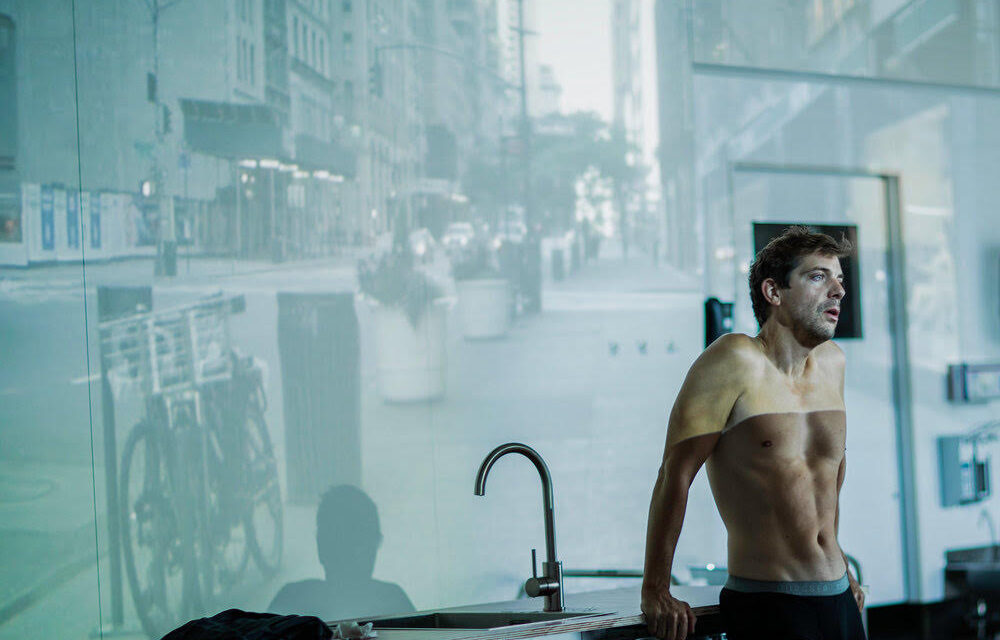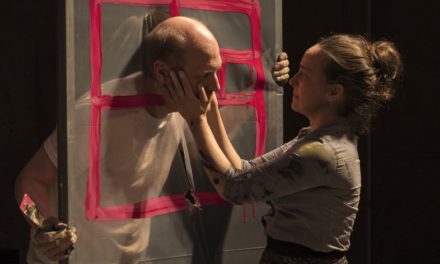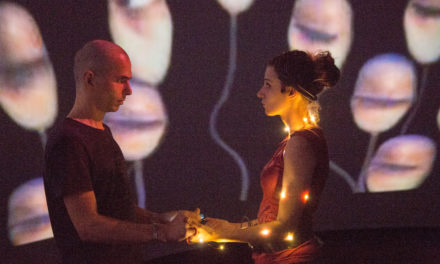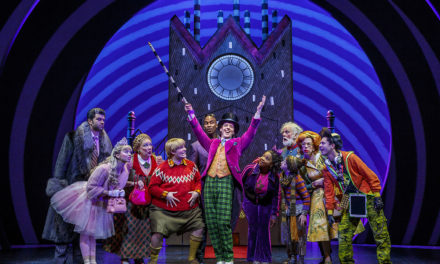There’s a colloquialism within the theatre community that ‘you know lighting design is good when you don’t notice it.’ While the validity of that statement remains debatable, the future of transmedia theatre could be in a similar direction. It’s certainly true that high-profile productions utilizing VR and robot actors are evidence of technology’s influence on theatre, but the future of transmedia may be more successful in its subtleties. In his keynote at IETM, Joris Weijdom defined the term mixed reality in how it related specifically to live performance and theatre studies. Technically, he clarifies, our entire world is made up of mixed reality, the combination of our physical bodies and the sensory information we interpret alongside digital information. As we move toward a theatre that increasingly includes digital media, there’s a growing demand for language to use for how the inclusion of multimedia affects our traditional understanding of scenography and dramaturgy. What does it mean for something to be represented in the different realms? Will they seamlessly blend or purposefully contradict?
A Little Life by Hanya Yanagihara was a worldwide bestseller when it first was released in 2015, both loved and panned by reviewers. The novel is over 800 pages and became known for its difficult subject matter to the point where critics of the book sometimes describe it as ‘torture porn’ referring to the horrific, lifelong abuse the main character endures which some readers found gratuitous. In fall 2018, a stage adaptation was produced by the ITA-ensemble (formerly Toneelgroep Amsterdam) at Internationaal Theater Amsterdam. Toneelgroep Amsterdam was started in 1987 by Gerardjan Rijndersand has been under the leadership of Ivo van Hove since 2001, who frequently directs the ensemble of actors and directed A Little Life. The production has since been reproduced in different theaters across Europe using live projected captions to translate the play originally performed in Dutch.
A Little Life follows a group of four college friends living in New York City from their twenties through the end of their lives. The novel starts with rotating narration, but soon the story is told consistently from the point of view of Jude, who is haunted by multiple traumatic events that took place throughout his childhood. Jude is affected by chronic pain and mobility problems as a result of being physically abused repeatedly and has a long history of intense self-mutilation as a coping mechanism. At the start of the novel, Jude’s past is a mystery to the reader as well as his three best friends: Willem, JB, and Malcolm. A series of flashbacks reveals different significant moments of Jude’s past. Throughout the course of the novel, Jude goes through many periods of both recovery and further deterioration. A Little Life tells the story of a man who suffers through unrelenting abuse and trauma while also being met with love and kindness every step of the way. Yanagihara frequently describes the book as a kind of fairytale, giving Jude a nightmarish backstory and the right circumstances for a happily ever after. As much as the healing power of love and friendship is a theme explored in this piece, equally important is the idea that fully recovering from trauma, unfortunately, does not always happen. Jude goes on to live a successful life surrounded by people who cared about him, but whether or not he ever ‘gets better’ can’t be answered; trauma doesn’t always work like that.
One of the biggest challenges in adapting a novel for the stage or screen is what may be lost by not having the protagonist’s internal monologue, which is especially important for this piece because of its themes of trauma and mental health. It’s crucial to the story to show how Jude is reminded of his traumatic past and how pervasive it is in his life many years later. One solution to this is the production’s incorporation of video and projections into the set (scenography and lighting design by Ivo van Hove’s husband and ITA-ensemble’s regular designer Jan Versweyveld). The multimedia element of A Little Life comes through both how video monitors are incorporated into the set pieces and larger video projections are used on the two side walls of the set. The style of the set can be best described as deconstructed naturalism, with different furniture pieces strewn about to represent multiple domestic settings interspersed with screens showing live video throughout to create an almost cubist effect. For instance, a record player plays onstage during living room scenes with a monitor built into the table it sits on showing an aerial view of the spinning record. When a character plays a new record, the audience watches it spin from above. A Little Life is staged with a profile set, with the audience on two sides of the stage. During the time the play is set in the timeline of the plot, video footage of New York City is projected on those walls constantly in motion as if the audience is in a taxi moving through the streets and stopping at traffic lights. This setting gives way to blank walls whenever Jude’s backstory is told through flashback. In moments when Jude is going through the ritualistic motions of self-harm — cutting, cleaning, and bandaging his wounds — the city is washed out with an overlay of television static.
The effect perfectly enacts the idea of mixed reality. Scenic design in mixed reality theatre environments, like that of A Little Life, poses a question about how the multiple physical and virtual spaces simultaneously exist. Live video monitors like the record player give us a cubist view of the apartment, bombarding us with images of this self-contained world. Conversely, the set’s walls are a constant reminder that there is in fact an outside world, despite the fact that so much of this play is focused on the internal life and relationships of this one character. The projections of the city representing the outside world are then shut away any time Jude’s pain takes over his perception of the world. Both techniques insulate the world of these characters. Jude’s pain is so intense, his immediate world is all he can conceive.
Adapting for the theatre is a challenge, but going from a strictly text-based source material can be particularly tough because of how it’s often set on one perspective. In this case, the use of different mediums in performance was the solution to this problem, enabling the audience to see the internal feelings of a character represented visually through film and projection. In this story, mental health and the lasting effects of trauma are themes that reverberate throughout the entire plot. This production not only finds a way that is unique to theatre to portray this nuance, it adds a new element to the story through its visual design making Ivo van Hove’s A Little Life a successful adaptation and successful piece of transmedia theatre.
This post was written by the author in their personal capacity.The opinions expressed in this article are the author’s own and do not reflect the view of The Theatre Times, their staff or collaborators.
This post was written by Olivia Ek.
The views expressed here belong to the author and do not necessarily reflect our views and opinions.


















